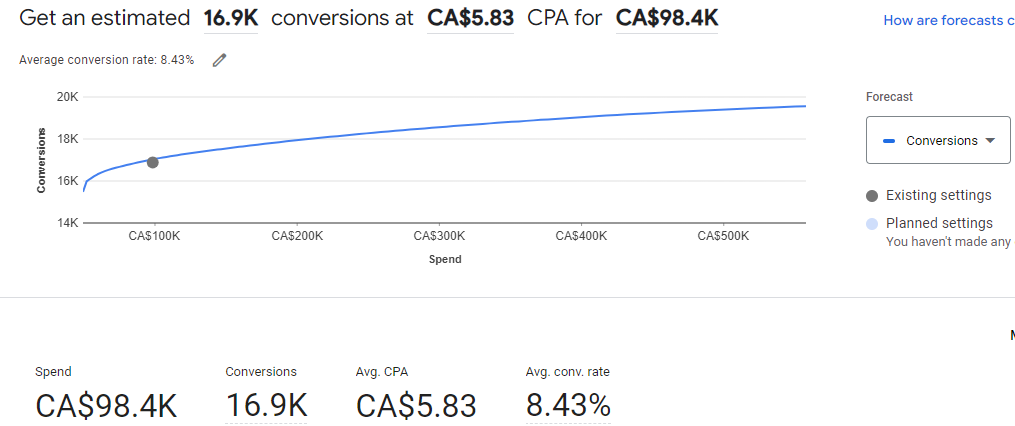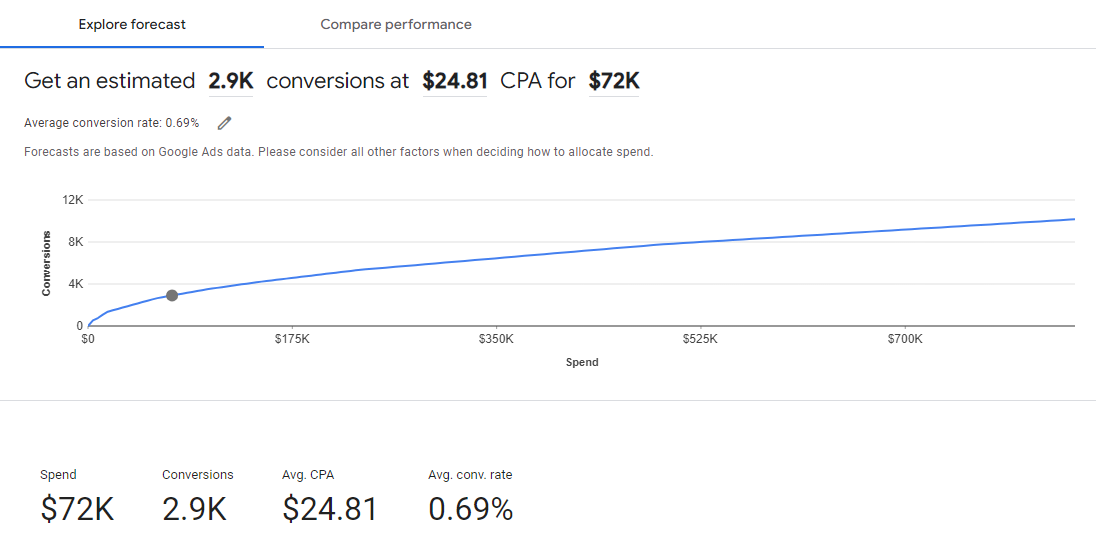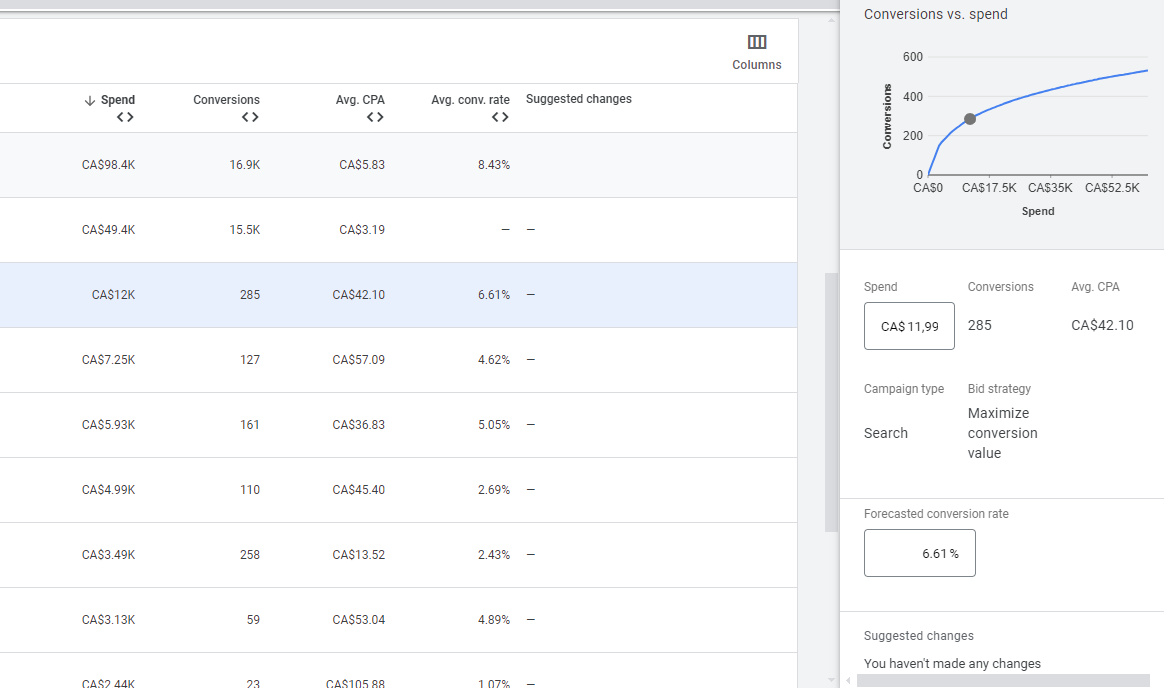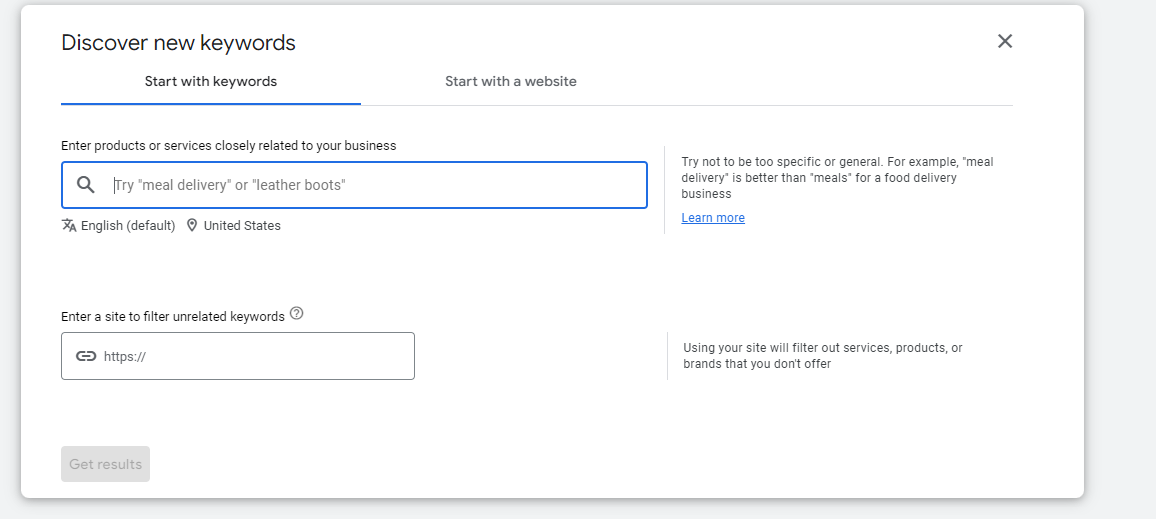
Getting to page 1 on Google today requires not only excellent search engine optimization but also excellent paid search management. It can be difficult to optimize your paid search channel on your own.
Lucky for you, Google Ads features the Performance Planner, which can help you see how your pay-per-click (PPC) campaigns are projected to perform. This way, you can properly plan out your budget and gain a better understanding of your overall paid search campaign performance.
Let’s look at the ins and outs of how you can utilize the Google Ads Performance Planner to maximize your paid search channel’s growth.
What is the Google Ads Performance Planner?
The Performance Planner is a strategic tool that can help you navigate any type of Google Ad campaign. It can not only help you forecast your search ad campaign as it is, but it can also provide actionable insights for ways you can maximize conversions with your budget. It can help you allocate budgets across accounts and campaigns and better understand opportunities during seasonal periods. Most of all, it can improve your return on investment so you can drive more conversions within your target CPA.
Why Use The Performance Planner?
Why should you use Google’s Performance Planner? Think of the Performance Planner as your master guide for Google Ads optimization.
Having trouble setting a realistic advertising budget for your search ad campaign?
Performance Planner lets you test out different advertising budget allocations as well as explore how different changes to the campaigns can affect your key metrics and overall performance. If you have a specific conversion goal in mind, like a specific conversion rate or return on ad spend (ROAS), you can use this tool to forecast specifically for each goal. It can even show you the best way to spread out a single budget across multiple campaigns or ad groups.
Maybe your business does really well in the summer but not in the winter. If you’re worried about seasonal market changes, Performance Planner uses historical data and machine learning to provide you with the best spending opportunities on a week-by-week basis.
How Does The Performance Planner Work?
You’re probably wondering: How does the Performance Planner work? And how accurate is it?
Performance Planner forecasts use billions of search queries, refreshed daily, to give you the most accurate performance predictions. Using this information, it will run simulations on relevant ad auctions over the last 7-10 days, including variables like competitor activity, seasonality, and landing pages.
Once it’s done collecting historical data and running simulations, Google utilizes machine learning to measure accuracy and fine-tune your forecasts, so you can make informed decisions to improve your paid search results.
Navigating The Performance Planner
Now that you’re aware of its benefits and how it works, let’s jump into how you can properly navigate the Performance Planner for success. When you create a plan for a specific campaign, you start by creating a “Draft Page.” A “Draft Page” contains the Forecast Graph, Individual Campaign Forecast Table, and Campaign Side Panel.
You also have the option to navigate to the Tools tab, where you can utilize the Performance Planner for an existing campaign, and proceed to select “Create Plan.”
Forecast Graph

The Forecast Graph shows you how changes in overall ad spend will impact your campaign performance. This will help you maximize your return on ad spend (ROAS) for your PPC campaigns.
Individual Campaign Forecast Table

The Individual Campaign Forecast Table lets you analyze how changes to your bid strategy will affect these three metrics:
- Campaign Spend
- Conversion Rate (CR)
- Cost-Per-Acquisition (CPA)
Each of these metrics is divided into three categories:
- “Planned”: Predicted metrics if you implement Google’s suggestions.
- “Expected”: Predicted metrics if you continue on your current path.
- “Diff”: This measures the difference between planned and expected outcomes.
Analyzing the Individual Campaign Forecast table will help you set a realistic budget to maximize conversions and return on investment for your search campaign.
Campaign Side Panel

The Campaign Side panel is made specifically for Google Ad portfolios with over 20 campaigns. It shows you a forecast graph, budget, and performance metrics for one campaign at a time. Here, you can adjust individual campaign settings like time range, total spend, keywords, advertising partners, bidding strategy, and campaign type in order to visualize the impact on your goals.
Compare Feature

The compare feature allows you to compare your past PPC campaign performances to anticipate future trends. This can be especially useful for big sales. Let’s say you are planning a sale or promotion for Black Friday/Cyber Monday. You can compare your past BFCM campaigns with your future BFCM forecast to see what tweaks you need to make to reach your performance goals.
Keyword Planner
The dynamic Keyword Planner tool seamlessly finds keywords relevant to your products or services, leveraging comprehensive keyword research capabilities. The tool also offers insights into search frequency and trends, allowing you to analyze how user queries evolve. Plus, with bid estimates provided for each keyword, you can confidently strategize your advertising budget for optimal results. From uncovering new keywords to fine-tuning bidding strategies, Keyword Planner equips you with the essential data to drive your advertising success.

Eligibility Criteria & Activation
It is important to note that only certain types of search campaigns can use Performance Planner. To read more about the eligibility criteria for search campaigns, shopping campaigns, display campaigns, app campaigns, local campaigns, video campaigns, Demand Gen campaigns, and Performance Max campaigns, click here for Google’s official guidelines.
It is also important to remember that the Performance Planner is strictly a tool for planning, not implementing. You can’t implement changes directly like the Keyword Planner, which allows you to add new keywords to campaigns. To activate the proposed changes from Performance Planner, you’ll need to download the changes from the planner and then directly upload the file into Google Ads Editor.
Work With Our Team Of PPC Experts
In the constantly evolving world of PPC, tools like the Google Ads Performance Planner are the key to staying ahead of the curve. At eAccountable, our paid search team utilizes the Performance Planner to elevate our client’s paid search channels to the top of their respective industries. We’ve driven a +230% year-over-year revenue increase for a leading dietary supplement company as well as +$32M in growth over 18 months for a luxury chair company. Working together, we can get you to page 1 of Google so you can convert high-value customers with precision.
Interested in learning more? Drop us a line here for a free consultation with our search engine marketing team.
